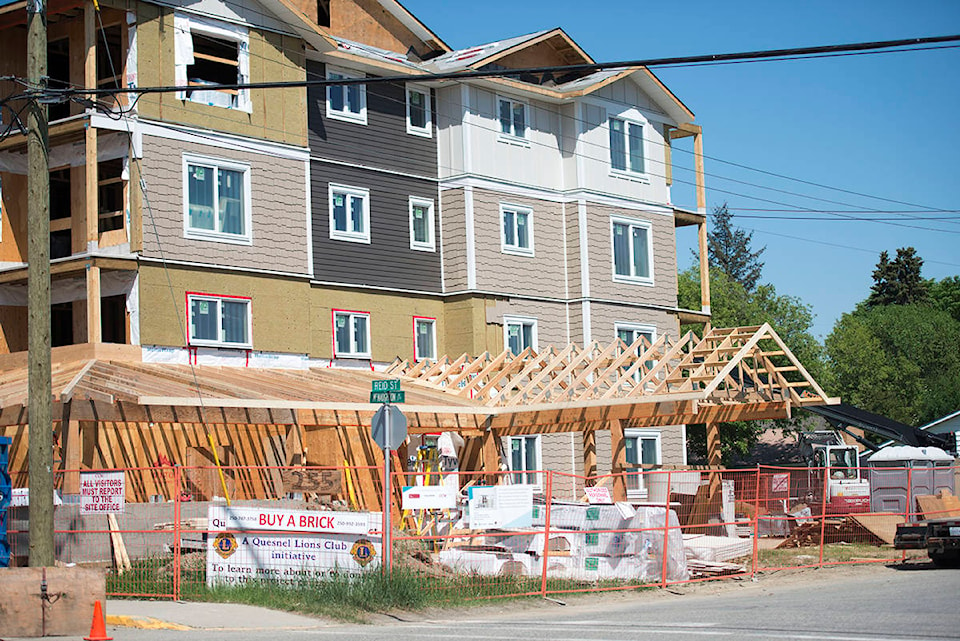A draft checklist for the City of Quesnel to address housing needs includes actions such as permitting secondary suites in residential areas, hosting a housing forum and considering an affordable housing reserve fund.
Council received the final version of the North Cariboo Housing Needs, Gap Analysis and Action Plan, which was completed by Urbanics Consultants Ltd. out of Vancouver, at its Nov. 26 meeting. The report was originally presented to the North Cariboo Joint Planning Committee in early October, and then some revisions were made after the consultants received recommendations from the meeting and from the City of Quesnel’s housing committee.
The report covers Areas A, B, C and I in the Cariboo Regional District (CRD) and the City of Quesnel. The CRD and the City retained Urbanics Consultants Ltd. in March 2019 to carry out this work, and at the same time, a housing committee was set up to provide advice and recommendations to the consultants on the report. As well, the City received a grant from the Northern Development Initiative Trust this fall to hire a housing planner for one year to help implement the recommendations of the Housing Action Plan.
The City’s community housing planner, Lindsay Allman, presented the final report to council Nov. 26.
Allman presented four key findings from the housing needs and gap analysis. The first is a lack of serviced, desirable lands, as the price points for lots are often too low for developers to cover their costs of development and make an incentivizing profit margin, and about nine per cent of the local housing stock is in major disrepair. The report also found there is a rapidly aging population, and the region and the municipality lack sufficient and appropriate housing stock for older adults who may be looking to downsize or must downsize due to mobility challenges. Declining household sizes and slow population growth is another key finding, as the community averages smaller-sized households than the provincial average, and there are declining youth and working-age populations. Local affordability is another key issue, and the report found about 45 per cent of Quesnel residents cannot afford single-family detached homes that are currently available on the market.
The Housing Action Plan (HAP) builds upon seven focused areas identified through the needs and gap analysis section.
The seven themes are:
• Address market-rate housing needs
• Address non-market housing needs
• Enhance supply of rental housing
• Enhance housing affordability
• Maintain the quality of the current housing stock
• Facilitate development on vacant lands
• Prepare for anticipated growth in population aged 65 and older
Some of the strategies associated with these seven themes include enhancing the supply of entry-level housing for young adults and professionals and senior-appropriate housing; working with other levels of government, community agencies and the development community to address housing affordability issues in terms of seniors’ housing and below-market-rate housing; facilitating rental housing supply; promoting the sustainable development of more affordable housing units; and ensuring there is adequate accessibility in housing for seniors.
The Housing Needs, Gap Analysis and Action Plan provides recommendations and possible next steps for the City of Quesnel, the CRD and community partners to consider. City staff is creating a checklist and ongoing work plan to track the City’s progress on items identified in the HAP to make use of the findings in the report. Allman explained the work plan and checklist are adjustable documents that are subject to priorities identified by council and City staff, and as the community housing planner, she will actively monitor and work towards the items identified in the checklist.
The checklist includes items that can be done within a year, in one to two years, from two to three years, in two to four years and in two to five years. Items range from updating the Zoning Bylaw to permit suites in residential areas, allow for smaller lot sizes, allow for increased density and reduce parking requirements in multi-family developments, to developing land concepts and potential requests for proposals on relevant public land and considering allocating resources to create a Rent Seeker program.
Along with working through the checklist, several ongoing initiatives will occur, including connecting with partners and facilitating development; encouraging and promoting rental buildings, senior homes and other areas of need; encouraging sustainable design in new builds; monitoring and reviewing the progress of housing developments; continuing the Housing Committee as appropriate for generating ideas; and continuing support for homelessness services and other non-profits in the City.
The City’s next steps will be to consider what suggested actions in the report are appropriate and desirable for the City to undertake through ongoing initiatives, continued outreach and policy changes.
“I have to question what our goal is here,” Coun. Ron Paull said after Allman’s presentation. “I’m seeing a lot about densification of existing housing stock but don’t see a lot to encourage new residential development.”
Allman told council there are many pieces to the puzzle.
“Based on our municipal services, it makes sense to make the best use of our land right now,” she said. “At the same time, we definitely want new market housing.”
Coun. Mitch Vik noted the Housing Action Plan highlighting the need to ensure adequate accessibility in housing for seniors and allowing residents to age in place dovetails nicely with other initiatives in the community, such as the City’s Age-Friendly Communities Initiative.
For more information and online versions of the housing report, visit quesnel.ca/city-hall/major-initiatives/housing-needs-assessment-gap-analysis-and-action-plan.
